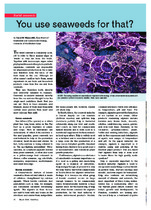| dc.contributor.author | Maneveldt, Gavin | |
| dc.date.accessioned | 2014-01-28T13:54:20Z | |
| dc.date.available | 2014-01-28T13:54:20Z | |
| dc.date.issued | 2006 | |
| dc.identifier.citation | Maneveldt, G.W. (2006). You use seaweeds for that? Veld & Flora, 92 (1): 24-25 | en_US |
| dc.identifier.issn | 0042-3203 | |
| dc.identifier.uri | http://hdl.handle.net/10566/979 | |
| dc.description.abstract | Introduction: The word seaweed is commonly used, yet to refer to these marine algae as 'weeds' is very far from the truth. Together with microscopic algae called phytoplankton and other photosynthetic organisms, seaweeds are responsible for all primary production in the oceans and therefore form the basis of the food chain in the sea. Although we often cannot smell or taste them, many ingredients in our foods and household products come from the sea and from seaweeds. They are therefore both directly and indirectly valuable to humans. Seaweeds assimilate minerals directly from the sea and are thought to be the single most nutritious foods that you can eat. Rich in trace elements and vitamins, many of them may frequently contain more protein than meat and more calcium than milk. | en_US |
| dc.language.iso | en | en_US |
| dc.publisher | Botanical Society of South Africa | en_US |
| dc.rights | Copyright Botanical Society of South Africa. Permission has been given to reproduce this file in the Repository. | |
| dc.subject | Assimilate | en_US |
| dc.subject | Household products | en_US |
| dc.subject | Marine algae | en_US |
| dc.subject | Primary production | en_US |
| dc.title | You use seaweeds for that? | en_US |
| dc.type | Article | en_US |
| dc.privacy.showsubmitter | false | |
| dc.status.ispeerreviewed | false | |

